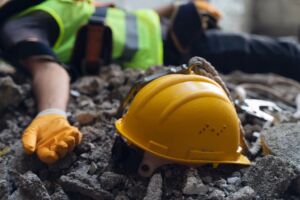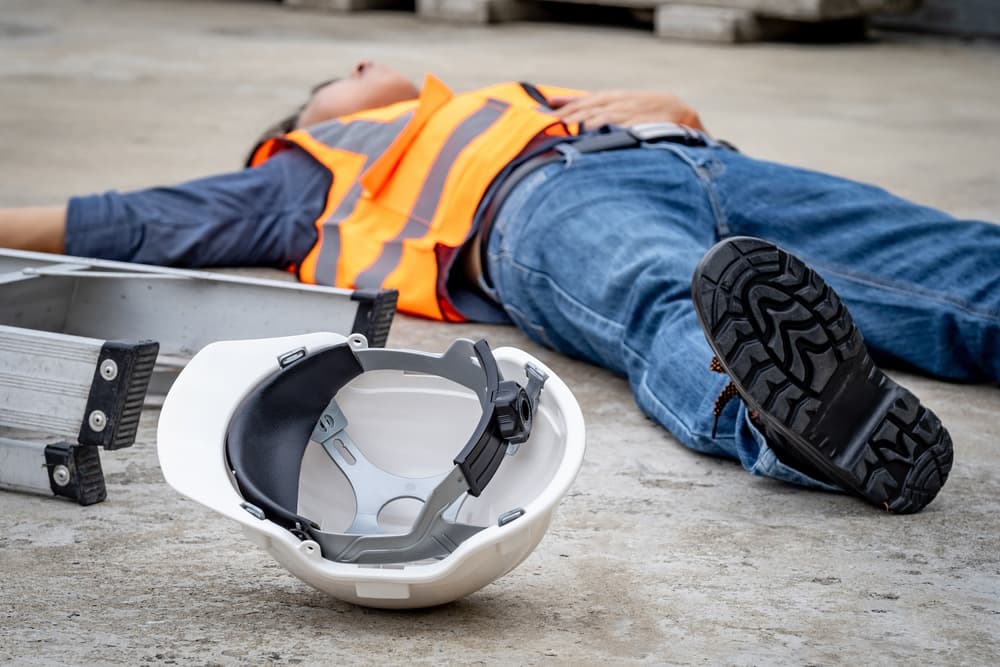Every year, falls account for more deaths in construction than any other cause. Yet many of these tragedies and other construction accidents occur despite long-standing safety regulations and basic protective gear. So why do they keep happening? And what are your rights if it happens to you?
What happens after a fall on a construction site depends on many factors — the type of injury, who was at fault, and whether you’re covered by workers’ compensation or eligible for a third-party injury claim.
It’s not your job to figure that all out. But it is your right to take action, ask questions, and seek help. A serious fall doesn’t just impact your ability to work. It can affect your mobility, your income, and your future. A construction accident lawyer can help you understand what steps to take and what options may be available, so you can focus on healing while someone else fights for accountability.
Key Takeaways for Construction Accident Fall Injuries
- Falls are the leading cause of death and injury on construction sites, often due to preventable safety failures.
- You may have more than one legal option for compensation. Workers’ compensation is often only part of the picture.
- Not all falls are caused by employer error; third parties such as contractors or equipment manufacturers may share liability.
- Acting quickly helps preserve evidence, protect your rights, and build a stronger claim.
- An attorney can help you explore all avenues for compensation and manage the legal process on your behalf.
The Most Common Causes of Falls on Construction Sites
 Construction work involves constant movement between levels — scaffolding, ladders, rooftops, and elevated platforms. These conditions increase the risk of a fall, especially when basic safety rules aren’t followed. OSHA has identified four main hazards that lead to most fatal falls, and many fall injuries stem from these same causes.
Construction work involves constant movement between levels — scaffolding, ladders, rooftops, and elevated platforms. These conditions increase the risk of a fall, especially when basic safety rules aren’t followed. OSHA has identified four main hazards that lead to most fatal falls, and many fall injuries stem from these same causes.
- Unprotected edges and floor openings: Holes or open sides without guardrails
- Improper use of ladders: Using the wrong ladder type, unsecured ladders, or improper angles
- Scaffold collapses or failures: Often tied to overloading or missing fall protection
- Faulty or missing personal protective equipment (PPE): Lack of harnesses, lifelines, or anchor points
These risks are not theoretical. In one recent year, OSHA issued over 5,000 citations for violations of fall protection standards, making it the most cited safety issue in construction. If you were injured in a fall, your case might involve OSHA fall protection construction violations or other workplace safety failures that point to employer or third-party negligence.
What to Expect Physically After a Construction Fall
Falling from a height puts enormous strain on the body, especially the spine, head, and lower limbs. Some injuries are immediately visible. Others develop in the hours or days that follow. These can range from temporary setbacks to permanent impairments.
Physical injuries that often result from construction site falls include:
- Broken bones: Often in the wrists, arms, legs, ribs, and pelvis
- Head trauma: Concussions and traumatic brain injuries (TBI) from direct impact or whiplash-type motion
- Spinal cord injuries: Neck and back injuries, which may lead to partial or full paralysis
- Internal bleeding or organ damage: Especially in abdominal or chest trauma
- Long-term mobility loss or chronic pain: Even after maximum healing, functionality may not return
Some symptoms take time to show up. That’s why it’s important to seek medical care right away, even if you initially feel okay. Early medical records also strengthen your claim by creating a clear link between the fall and your injury.
Can You Sue After a Fall on a Construction Site?
Most construction workers are eligible for workers’ compensation benefits. These cover medical bills, a portion of lost wages, and disability payments. In Indiana, injured workers generally have 30 days to notify their employer and two years to file a claim, according to the Indiana Workers’ Compensation Act (Indiana Code § 22-3-3).
Many workers assume that if they fall at work, their only option is filing for workers’ compensation. However, while workers’ comp is a primary path, it’s not always the only one, and in many cases, it isn’t enough.
Here are two additional legal paths to compensation that may be available to you, depending on your case:
Third-Party liability claim
If a party other than your employer, such as a subcontractor, property owner, or equipment manufacturer, caused or contributed to your injury, you may pursue a third-party liability construction site claim under general negligence principles. This opens the door to damages not covered by workers’ comp, including full lost wages, pain and suffering, and loss of future earning potential.
Premises liability or general negligence
If your injury occurred on a site where another party controlled safety, such as a general contractor, for instance, you may be able to pursue a third-party liability construction site claim under general negligence principles. These cases are more complex but can also lead to broader compensation than what workers’ comp provides.
An experienced lawyer will review the specifics of your situation to identify who may be held accountable and what types of claims can be filed.
How Indiana’s Laws Affect Construction Fall Injury Claims
Construction accident laws vary by state, and Indiana has some important rules that may impact your case. Here’s what to know if you were injured on a construction site in Indiana.
Indiana’s modified comparative fault rule
Indiana uses a modified comparative fault rule (Indiana Code § 34-51-2-6). This means you can recover damages only if you were less than 51% at fault for the incident. If you’re found to be partially at fault, your compensation will be reduced by your percentage of responsibility.
For example, if a jury finds that you were 20% at fault because you didn’t use your harness correctly, and your total damages are $100,000, you could still recover $80,000.
Statute of limitations for personal injury in Indiana
Like most states, Indiana sets a deadline for filing personal injury lawsuits. For construction site fall injuries, the general statute of limitations is two years from the date of the injury (Indiana Code § 34-11-2-4). However, certain factors may affect this window, such as if the injured party is a minor or if the injury wasn’t discovered immediately.
Missing this deadline can permanently bar your ability to recover compensation. It’s important to take action well before the clock runs out.
When Employers Are Responsible and When They’re Not
Many construction site falls happen because someone failed to follow proper safety protocols, whether that’s an employer, contractor, or another party responsible for site conditions.
OSHA and state laws require employers to follow specific safety protocols to protect construction workers from falls. Failure to comply may form the basis of a legal claim.
However, some situations fall outside the employer’s direct control. Here are examples of each:
 The employer might be responsible if:
The employer might be responsible if:
- No guardrails were installed on upper levels
- Workers weren’t trained in fall prevention
- Equipment was damaged or outdated
- Safety checks were skipped
The employer might not be responsible if:
- Something a subcontractor did or failed to do caused the fall
- Equipment failure stemmed from a manufacturer’s defect
- The site owner allowed unsafe conditions without notifying the crew
Identifying the right parties is key to building a strong case. This is where legal representation becomes especially helpful. A construction accident lawyer can focus on building your case and protecting your interests while you recover.
What to Do After a Construction Fall Injury
Once you’ve received initial medical care, the days and weeks that follow can feel uncertain. Many workers aren’t sure what to do next, especially if they’re unsure whether they’ll heal fully or be able to return to work. Taking a few key steps early on can protect your health, your job, and your potential claim.
After a construction site fall, it helps to:
- Report the incident immediately to your supervisor or site manager, even if you think the injury is minor.
- Request a copy of the accident report, and make sure the details are accurate.
- Seek follow-up medical care and stick to your treatment plan to document your recovery.
- Gather names and contact info of coworkers who witnessed the fall.
- Take photos of the location where you fell, if you’re able to safely do so.
These steps don’t guarantee compensation. But they help preserve evidence and document the harm you’ve suffered, strengthening your legal position. You don’t need to take them alone. Many injured workers find relief in letting a lawyer handle communications, documentation, and legal follow-up while they focus on healing.
Who Might Be Liable for Your Fall?
In construction injury cases, fault is rarely straightforward. Multiple companies may be working on the same site. Equipment might be leased or installed incorrectly. Safety oversight might be outsourced. The key question isn’t just what happened — it’s who had the responsibility to prevent it.
In fall cases, potentially liable parties include:
- Your direct employer, if they failed to follow OSHA safety rules or didn’t provide proper training or gear
- The general contractor, if they managed the site and failed to correct hazards
- Subcontractors whose negligence created unsafe working conditions
- Property owners, if they allowed known dangers or failed to address risks
- Equipment manufacturers, if defective scaffolding, ladders, or PPE contributed to the fall
Each of these parties may carry different types of insurance. Determining who’s responsible often requires site investigations, interviews, and expert input. But you don’t have to chase those answers yourself. An experienced attorney can uncover who may be legally and financially accountable for your injury.
What Compensation Might Be Available After a Construction Fall?
The injuries caused by a fall can last long after the cast comes off or the staples come out. You may miss weeks or months of work. In severe cases, you may never return to your old job. Compensation can help offset those losses and give you the support you need to move forward.
Compensation for a fall on a construction site may cover:
- Medical expenses related to emergency care, surgery, rehab, and ongoing treatment
- Lost wages while you’re unable to work, including past and future income
- Disability payments if your injury limits your ability to earn a living
- Pain and suffering for physical pain, emotional distress, and reduced quality of life
- Out-of-pocket costs such as transportation, medication, or home modifications
Workers’ compensation generally covers medical care and a portion of lost wages, but it does not include pain and suffering. That’s why third-party claims are so important. If someone outside your employer contributed to the fall, you may have the right to pursue additional compensation that reflects the full scope of your loss.
How a Lawyer Can Help After a Construction Site Fall
You don’t need to know which type of claim applies to your case. That’s a lawyer’s role. But having legal help early can make a meaningful difference, especially when insurance companies are already looking for ways to limit their payout.
An attorney can support your recovery in several key ways:
1. Investigate the cause of the fall
They examine site conditions, safety violations, witness accounts, and OSHA records to determine what went wrong.
2. Identifie liable parties
They determine whether the fault lies with your employer, a contractor, a property owner, or another third party.
3. Handle insurance communications
They deal directly with insurance companies and adjusters to protect you from lowball offers or pressure tactics.
4. Manage paperwork and deadlines
They file claims, track medical documentation, and ensure all legal timelines are met.
5. Pursue full and fair compensation
They advocate for financial recovery that accounts for both your immediate losses and your long-term future.
Your recovery is too important to leave to chance. A lawyer brings focus, strategy, and a level playing field, so you’re not left managing pain and paperwork at the same time.
FAQs About What Happens After a Fall on a Construction Site?
How much does it cost to hire a construction accident lawyer?
Most personal injury attorneys, including construction accident lawyers, work on a contingency fee basis. That means you don’t pay anything up front. The lawyer only gets paid if they recover compensation on your behalf.
Can I still file a claim if my employer is already paying workers’ comp?
Yes. Workers’ compensation and third-party claims are separate. You can receive workers’ comp benefits while also pursuing a personal injury claim against other parties responsible for your fall.
Do I need to prove my employer violated OSHA rules?
No. While OSHA violations can strengthen your claim, your lawyer can still pursue compensation even if no official citation was issued. Liability may be established through other types of evidence, such as site photos, witness statements, or maintenance records.
What if I didn’t report the fall right away?
Delays in reporting a construction fall can complicate your claim, but they don’t necessarily prevent you from recovering compensation. In Indiana, you generally have 30 days to notify your employer of a workplace injury under the Indiana Workers’ Compensation Act.
Failing to report the incident promptly may give insurers reason to question your claim, especially if there’s no immediate medical record. If you’ve missed that window or are unsure what was documented, a construction accident lawyer can review your situation and help clarify your options.
Can I recover compensation if I was working as an independent contractor?
Independent contractors may not qualify for workers’ compensation, but you may have a right to file a personal injury claim if someone else’s negligence contributed to your fall, such as a general contractor, property owner, or subcontractor. These cases require showing that another party failed to provide a reasonably safe work environment. A lawyer can help determine liability and whether third-party claims are available in your case.
Trusted Legal Support After a Serious Construction Fall

William W. Hurst, Construction Accident Lawyer
Falls on construction sites are often preventable, and when they happen, it’s not just about the physical damage. There’s fear, frustration, and uncertainty about what comes next. You deserve answers, support, and a legal team that’s ready to fight for full and fair compensation.
At Hurst Limontes LLC, our attorneys work directly with injured workers and their families to uncover the cause of the fall, determine who may be liable, and build a case that reflects the full impact of the injury, physically, emotionally, and financially.
We know what’s at stake. That’s why we offer free consultations, work on a contingency fee basis, and treat every case with the urgency and respect it deserves. If you were hurt in a construction fall, whether in Indianapolis, South Bend, Fort Wayne, or anywhere in Indiana, we’re here to help. Call us today at (317) 636-0808 or contact us online to schedule a free case review.


